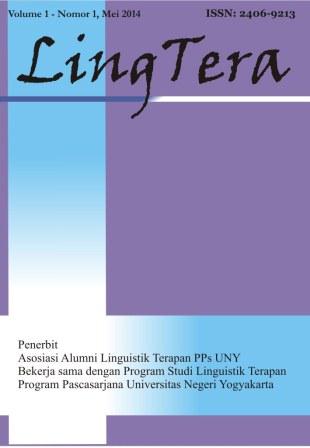Retensi dan adaptasi nama makanan asal Belanda di Indonesia
DOI:
https://doi.org/10.21831/lt.v9i1.61868Keywords:
Retensi, adaptasi, makanan Belanda, perubahan maknaAbstract
Penelitian ini memaparkan berbagai bentuk retensi dan adaptasi makanan asal Belanda yang hingga saat ini masih dapat dijumpai di Indonesia. Fenomena kebahasaan ini terjadi akibat kontak budaya yang cukup lama dengan bangsa Belanda di masa lalu. Data dikumpulkan dengan metode simak bebas libat cakap melalui penelusuran pustaka dan pengamatan saksama terhadap nama makanan yang terdapat di beberapa toko dan pasar, kemudian dicatat dan dikelompokkan berdasar pada bentuk nama makanan tersebut. Data dianalisis dengan metode padan referensial dan translasional untuk mengetahui makna nama makanan dan referennya. Hasilnya, terdapat nama-nama makanan hasil proses retensi dan adaptasi dari nama aslinya dalam bahasa Belanda. Retensi atau pemertahanan nama makanan dari bahasa Belanda terjadi dengan pemertahanan lafal dan ejaan, sedangkan adaptasi terjadi dengan penyesuaian lafal dan ejaan, adaptasi audial, penerjemahan langsung, dan perpindahan makna. Retensi dilakukan untuk ketepatan makna, penanda sejarah, dan identitas unik untuk pemasaran produk. Adaptasi dilakukan karena perbedaan fonologi bahasa Belanda dan Indonesia serta adaptasi dengan perpindahan makna dilakukan untuk menghindari kesalahmengertian dan unsur tabu akibat perbedaan kebudayaan masyarakat Belanda dan Indonesia.
This paper aims to elaborate kinds of retention and adaptation that took place in Dutch-origin foods which still be found in Indonesia. This linguistics phenomenon occurs as the result of long-term contact between Indonesia and the Dutch in the past times. The data was obtained from literary searching and thorough observation of food names that are sold in a traditional market and several bakeries, thus the data are noted and classified based on their forms. The obtained data were then analyzed by translational and referential methods to discover and elaborate the meanings of the food's names from Dutch and their referent. It results in two processes for naming Dutch-origin foods in bahasa Indonesia, which are retention and adaptation from their original names. Retention occurs by retaining the pronunciation and spelling, whereas adaptation occurs by adjusting the pronunciation and spelling, audial adaptation, direct translating, and meaning-switching. Retention was done for proper meaning, historical signs, and unique identity to marketing the foods. On the other side, adaptation occurs as the result of phonological differences between Dutch and bahasa Indonesia, and meaning-switching was done to avoid misunderstanding and taboo caused by cultural differences between the two.
References
BinnensteBuiten. (2019-September). Ambachtelijke kroketten van Oma Loekie [video file]. Available on https://www.youtube.com/watch?v=BoxuVPLwP5Q&t=1s&ab_channel=BinnensteBuiten.
Booij, G. 2015. Compounds and lexical phrases in Dutch [PDF]. Available on https://www.researchgate.net/publication/323771998.
Chaer, A. 2007. Leksikologi & leksikografi indonesia. Jakarta: PT Rineka Cipta.
Eenschooten, C. dan Matze, H. 2015. De hollandse keuken/dutch cuisine. Alphen aan de Rijn: Atrium.
Fitrisia, D., Sibarani, R., Mulyadi, & Ritonga, U. 2018. Traditional food in the perspective of culinary linguistics. International Journal of Multidisciplinary Research and Development, 5(2), 24"”27. ISSN: 2349-4182.
Handoyo, C. C., Clarissa, Claudia, G., Milka, & Firdayanti, S. A., 2017. Klappertaart: an indonesian-dutch influenced traditional food. Journal of Ethnic Foods, vol. 5, 147"”152. https://doi.org/10.1016/j.jef.2017.12.002.
Holten, N. 2010. Oliebollen [blogpost]. Available on https://www.thedutchtable.com/search/label/Oliebollen%20%28Dutch%20Fried%20Dough%20Balls%29.
Holten, N. 2013. Poffertjes (dutch mini pancakes) [blogpost]. Available on
https://www.thedutchtable.com/search/label/Poffertjes%20%28Dutch%20Mini%20Pancakes%29.
Holten, N. 2011. Zakdoekjes (dutch handkerchief cookies) [blogpost]. Available on https://www.thedutchtable.com/search/label/Zakdoekjes%20%28Dutch%20Handkerchief%20Cookies%29.
Kesuma, T. M. J. 2007. Pengantar (metode) penelitian bahasa. Yogyakarta: Carasvati Books.
Kramsch, C. 2009. Language and culture. Oxford: Oxford University Press.
Mahsun. 1995. Dialektologi diakronis: sebuah pengantar. Yogyakarta: Gadjah Mada University Press.
Pusat Bahasa Departemen Pendidikan Nasional. 2007. Pedoman umum pembentukan istilah edisi ketiga. [PDF]. Available on
https://badanbahasa.kemdikbud.go.id/resource/doc/files/Pedoman_Umum_Pembentukan_Istilah_PBN_0.pdf.
Postma, J. 1979. Grootmoeders kookboek: 1000 recepten anno 1990. Ridderkerk: Gradivus.
Renier, F. G. 1961. Dutch-english and english-dutch dictionary. London: Butler & Tanner Ltd.
Surinaamse Keuken. (2020-December). Kipkroketten maken – Make Chicken Croquettes | EN subtitle | [video file]. Available on https://www.youtube.com/watch?v=p4-_6otfUr8&t=759s&ab_channel=SurinaamseKeuken.
Surinaamse Keuken. (2022-December). Kipbitterballen maken |chicken bitter balls recipe| [video file]. Available on https://www.youtube.com/watch?v=i9IxBlkaEhQ&ab_channel=SurinaamseKeuken.
Toine's Kitchen. (2021-March). How to Make Pasteitje: Dutch Vol-Au-Vent Recipe [video file]. Available on https://www.youtube.com/watch?v=rRPWvFfN2Ho&ab_channel=Toine%E2%80%99sKitchen%F0%9F%87%B3%F0%9F%87%B1.
Toine's Kitchen. (2022-January). How to Make Smoor Djawa: Indonesian Beef Stew with Potatoes [video file]. Available on https://www.youtube.com/watch?v=3qaPiJLG6tE&ab_channel=Toine%E2%80%99sKitchen%F0%9F%87%B3%F0%9F%87%B1.
Wierzbicka, A. 1997. Understanding culture through their keywords. New York: Oxford University Press.
Downloads
Published
How to Cite
Issue
Section
Citation Check
License
LingTera allows readers to read, download, copy, distribute, print, search, or link to its articles' full texts and allows readers to use them for any other lawful purpose. The journal allows the author(s) to hold the copyright without restrictions. Finally, the journal allows the author(s) to retain publishing rights without restrictions.
- Authors are allowed to archive their submitted articles in an open-access repository.
- Authors are allowed to archive the final published article in an open-access repository with an acknowledgment of its initial publication in this journal.

Psychology, Evaluation, and Technology in Educational Research is licensed under a Creative Commons Attribution-ShareAlike 4.0 International License.
Based on a work at https://petier.org/index.php/PETIER.









